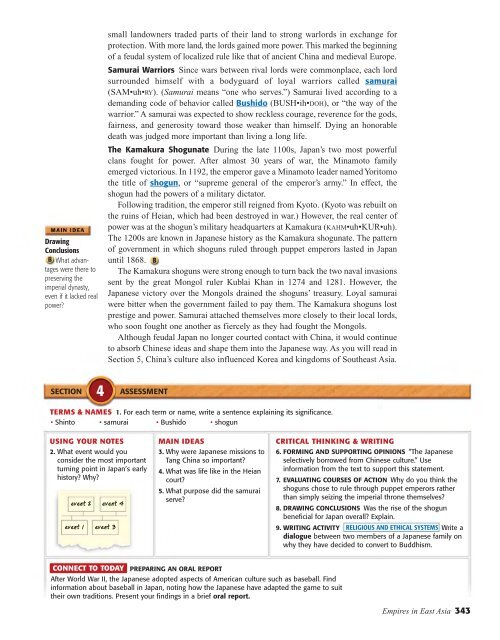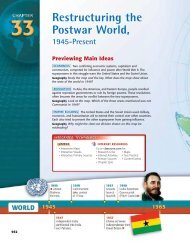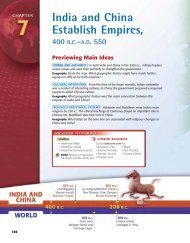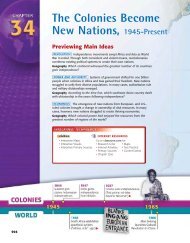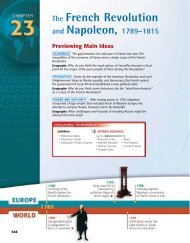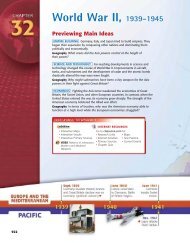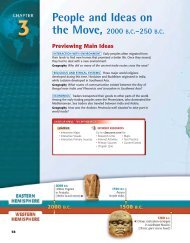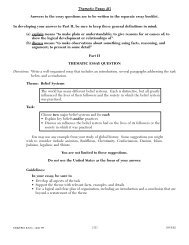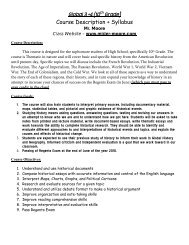Create successful ePaper yourself
Turn your PDF publications into a flip-book with our unique Google optimized e-Paper software.
Draw<strong>in</strong>g<br />
Conclusions<br />
What advantages<br />
were there to<br />
preserv<strong>in</strong>g the<br />
imperial dynasty,<br />
even if it lacked real<br />
power?<br />
small landowners traded parts of their land to strong warlords <strong>in</strong> exchange for<br />
protection. With more land, the lords ga<strong>in</strong>ed more power. This marked the beg<strong>in</strong>n<strong>in</strong>g<br />
of a feudal system of localized rule like that of ancient Ch<strong>in</strong>a and medieval Europe.<br />
Samurai Warriors S<strong>in</strong>ce wars between rival lords were commonplace, each lord<br />
surrounded himself with a bodyguard of loyal warriors called samurai<br />
(SAM•uh•RY). (Samurai means “one who serves.”) Samurai lived accord<strong>in</strong>g to a<br />
demand<strong>in</strong>g code of behavior called Bushido (BUSH•ih•DOH), or “the way of the<br />
warrior.” A samurai was expected to show reckless courage, reverence for the gods,<br />
fairness, and generosity toward those weaker than himself. Dy<strong>in</strong>g an honorable<br />
death was judged more important than liv<strong>in</strong>g a long life.<br />
The Kamakura Shogunate Dur<strong>in</strong>g the late 1100s, Japan’s two most powerful<br />
clans fought for power. After almost 30 years of war, the M<strong>in</strong>amoto family<br />
emerged victorious. In 1192, the emperor gave a M<strong>in</strong>amoto leader named Yoritomo<br />
the title of shogun, or “supreme general of the emperor’s army.” In effect, the<br />
shogun had the powers of a military dictator.<br />
Follow<strong>in</strong>g tradition, the emperor still reigned from Kyoto. (Kyoto was rebuilt on<br />
the ru<strong>in</strong>s of Heian, which had been destroyed <strong>in</strong> war.) However, the real center of<br />
power was at the shogun’s military headquarters at Kamakura (KAHM•uh•KUR•uh).<br />
The 1200s are known <strong>in</strong> Japanese history as the Kamakura shogunate. The pattern<br />
of government <strong>in</strong> which shoguns ruled through puppet emperors lasted <strong>in</strong> Japan<br />
until 1868.<br />
The Kamakura shoguns were strong enough to turn back the two naval <strong>in</strong>vasions<br />
sent by the great Mongol ruler Kublai Khan <strong>in</strong> 1274 and 1281. However, the<br />
Japanese victory over the Mongols dra<strong>in</strong>ed the shoguns’ treasury. Loyal samurai<br />
were bitter when the government failed to pay them. The Kamakura shoguns lost<br />
prestige and power. Samurai attached themselves more closely to their local lords,<br />
who soon fought one another as fiercely as they had fought the Mongols.<br />
Although feudal Japan no longer courted contact with Ch<strong>in</strong>a, it would cont<strong>in</strong>ue<br />
to absorb Ch<strong>in</strong>ese ideas and shape them <strong>in</strong>to the Japanese way. As you will read <strong>in</strong><br />
Section 5, Ch<strong>in</strong>a’s culture also <strong>in</strong>fluenced Korea and k<strong>in</strong>gdoms of Southeast <strong>Asia</strong>.<br />
SECTION 4 ASSESSMENT<br />
TERMS & NAMES 1. For each term or name, write a sentence expla<strong>in</strong><strong>in</strong>g its significance.<br />
• Sh<strong>in</strong>to • samurai • Bushido • shogun<br />
USING YOUR NOTES<br />
2. What event would you<br />
consider the most important<br />
turn<strong>in</strong>g po<strong>in</strong>t <strong>in</strong> Japan’s early<br />
history? Why?<br />
event 2 event 4<br />
event 1 event 3<br />
MAIN IDEAS<br />
3. Why were Japanese missions to<br />
Tang Ch<strong>in</strong>a so important?<br />
4. What was life like <strong>in</strong> the Heian<br />
court?<br />
5. What purpose did the samurai<br />
serve?<br />
CONNECT TO TODAY PREPARING AN ORAL REPORT<br />
After World War II, the Japanese adopted aspects of American culture such as baseball. F<strong>in</strong>d<br />
<strong>in</strong>formation about baseball <strong>in</strong> Japan, not<strong>in</strong>g how the Japanese have adapted the game to suit<br />
their own traditions. Present your f<strong>in</strong>d<strong>in</strong>gs <strong>in</strong> a brief oral report.<br />
CRITICAL THINKING & WRITING<br />
6. FORMING AND SUPPORTING OPINIONS “The Japanese<br />
selectively borrowed from Ch<strong>in</strong>ese culture.” Use<br />
<strong>in</strong>formation from the text to support this statement.<br />
7. EVALUATING COURSES OF ACTION Why do you th<strong>in</strong>k the<br />
shoguns chose to rule through puppet emperors rather<br />
than simply seiz<strong>in</strong>g the imperial throne themselves?<br />
8. DRAWING CONCLUSIONS Was the rise of the shogun<br />
beneficial for Japan overall? Expla<strong>in</strong>.<br />
9. WRITING ACTIVITY RELIGIOUS AND ETHICAL SYSTEMS Write a<br />
dialogue between two members of a Japanese family on<br />
why they have decided to convert to Buddhism.<br />
<strong>Empires</strong> <strong>in</strong> <strong>East</strong> <strong>Asia</strong> 343


